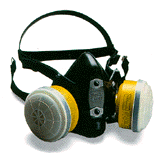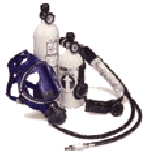Respiratory Protection eTool
Respirator Selection » Air-purifying vs. Atmosphere-supplying Respirators

Air-purifying Respirators have filters, cartridges, or canisters that remove contaminants from the air by passing the ambient air through the air-purifying element before it reaches the user.
Learn about the 3 different kinds of Air-purifying Respirators

Atmosphere-supplying Respirators supply clean air directly to the user from a source other than the air surrounding the user.
Learn about the 3 different kinds of Atmosphere-supplying Respirators

Particulate Respirators
- Capture particles in the air, such as dusts, mists, and fumes.
- Do not protect against gases or vapors.
- Generally become more effective as particles accumulate on the filter and plug spaces between the fibers.
- Filters should be replaced when user finds it difficult to breathe through them.

Gas & Vapor Respirators
- Are normally used when there are only hazardous gases and vapors in the air.
- Use chemical filters (called cartridges or canisters) to remove dangerous gases or vapors.
- Do not protect against airborne particles.
- Are made to protect against specific gases or vapors.
- Provide protection only as long as the filter's absorbing capacity is not depleted.
- The service life of the filter depends upon many factors and can be estimated in various ways.

Combination Respirators
- Are normally used in atmospheres that contain hazards of both particulates and gases.
- Have both particulate filters and gas/vapor filters.
- May be heavier.
Employers are required to provide employees using atmosphere-supplying respirators (supplied air and self contained breathing apparatus) with breathing gases of high purity, and shall ensure that compressed air, compressed oxygen, liquid air, and liquid oxygen used for respiration is in accordance with the specifications of OSHA Standard 29 CFR 1910.134(i).

Air-Supplied Respirators
- Makes use of a hose to deliver clean, safe air from a stationary source of compressed air.
- Provides clean air for long periods of time and are light weight for the user.
- Limits the range of user-mobility and may fail due to hose damage.
- Also called airline respirators.
- Are normally used when there are extended work periods required in atmospheres that are not immediately dangerous to life and health (IDLH).

Self-Contained Breathing Apparatus
- Consists of a wearable, clean-air supply pack.
- Do not restrict movement with a hose connection.
- The closed-circuit type can provide air up to 4 hours.
- The open-circuit type only provide air for 30 - 60 minutes.
- Are normally used when there is a short-time need to enter and escape from atmospheres which are or may be immediately dangerous to life and health (IDLH).

Combination Respirators
- Have an auxiliary self-contained air supply that can be used if the primary supply fails.
- The self-contained portion can be small since it only needs to supply enough air for escape.
- Can be used for entry into confined spaces.
- Are normally used when there are extended work periods required in atmospheres that are or may be immediately dangerous to life and health (IDLH).

